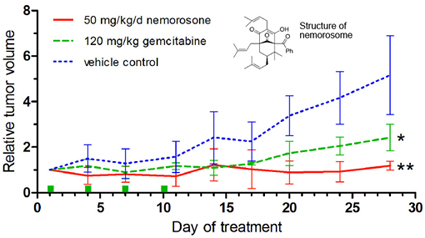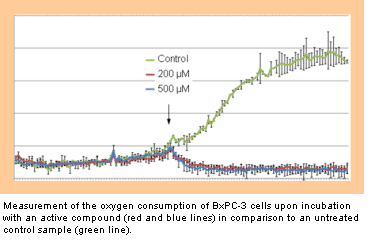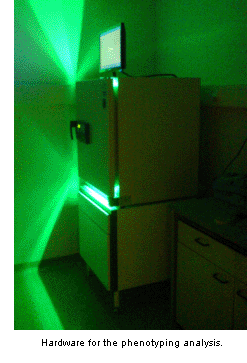Functional
Genome Analysis (B070)
Deutsches
Krebsforschungszentrum,
Im Neuenheimer Feld 580
D-69120
Heidelberg,
Germany. |
 |
.
.
..
|
FINISHED PROJECT:
Nemorosome-induced
cytotoxic effects on pancreatic cancer
o
Polycyclic
polyprenylated acylphloroglucinols (PPAPs) are a
class of compounds with various biological activities ranging from
anti-depressant, anti-cancer and anti-inflammatory to anti-microbial
activity.
Among them, hyperforin, has been shown to possess anti-cancer
properties in vitro and in vivo.
However, hyperforin strongly upregulates the expression of
CYP3A4, a member of the cytochrome P450 family involved in xenobiotics
metabolism, thus rendering it useless in a potential anti-cancer
combination
therapy approach.
...
Being structurally related to hyperforin, pronounced
anti-cancer properties have also been demonstrated in vitro
for nemorosone on cell lines of various origins. We
performed a detailed analyses of its mechanism of action on
pancreatic cancer
cells: rapid elevation of cyctosolic calcium levels and depolarization
of the
mitochondrial membrane was followed by activation of apoptosis via a
stress
response pathway known as the unfolded protein response. Interestingly,
differentiated normal cells were found to be ten times less sensitive
to
a
treatment with nemorosone, thus opening a potential therapeutic window
to
explore also its anti-cancer activity in
vivo.
...
We investigated the growth-inhibitory potential of
nemorosone
on pancreatic cancer xenografts and determined basic pharmacokinetic
parameters. At a dosis of 50 mg/kg nemorosone per day, a significant
growth-inhibitory effect was observed. Also, the compound was well and
rapidly
absorbed into the blood stream with a half-life of approximately 30 min.
...
Overall, Nemorosone is a potent anti-cancer lead compound
with good bioavailability, little side-effect and good
growth-inhibition, thus
potentially representing a valuable component for a combination therapy
approach.
...
Wolf et al. (2013) PLoS ONE
8,
e74555.  Simpkins et al. (2012) Bioorg.
Medicinal Chem. Lett. 22, 6144-6147.
Simpkins et al. (2012) Bioorg.
Medicinal Chem. Lett. 22, 6144-6147.  Holtrup et al.
(2011) Brit. J.
Pharmacol. 162, 1045-1059.
Holtrup et al.
(2011) Brit. J.
Pharmacol. 162, 1045-1059. 
|
|

Tumor volume and body
weight development in MIA-PaCa-2 xenograft mice. Mice were treated with
daily i.p. injections of 50 mg/kg nemorosone, vehicle only or 120 mg/kg
gemcitabine at the indicated time points (green dots). Tumor volume was
measured 2-3 times per week using a digital caliper. Values represent
the mean
± SD of 8 animals per group. * p < 0.05, ** p <
0.01 (compared to the
vehicle control).
|
S
.
FINISHED PROJECT:
Automated
high-content analysis platform for the development of individualised
therapy strategies (AHA)
  The
project consortium aimed at the establishment of
a platform system for the analysis of phenotypic and genotypic
parameters of
cancer cells or explanted cancer patient tissues. The system is
designed for
the generation of cell- and tumour-specific information that is
relevant for a
clinical classification and stratification of tumours of individual
patients
with respect to their in vivo chemosensitivity. The platform
could contribute to a personalised disease treatment, in particular to
an optimisation of
chemotherapy.
...
The platform is based on microphysiometric sensor
technology and imaging analyses. In combination with molecular
approaches, it
will be an innovative tool for cytophysiology and cytopathology.
...
A multiwell plate is at the heart of the platform.
It combines electrochemical impedance sensors and optochemical sensors.
Cell
cultures or patient tissues are monitored in real time. Parts of the
cultures
or supernatants are used for sampling for molecular analyses of the
cellular genome and proteome or the secretome, respectively.
...
The project provided a basis for clinical studies
that are anticipated in near future. The platform could become an
integral part
of personalised medicine approaches, contributing to both an increasing
effect of
cancer
therapeutics and the avoidance of unnecessary or contraproductive
treatment regimes. This would
improve individual health care quality and reduce the frequency and
intensity of side effects. The
project consortium aimed at the establishment of
a platform system for the analysis of phenotypic and genotypic
parameters of
cancer cells or explanted cancer patient tissues. The system is
designed for
the generation of cell- and tumour-specific information that is
relevant for a
clinical classification and stratification of tumours of individual
patients
with respect to their in vivo chemosensitivity. The platform
could contribute to a personalised disease treatment, in particular to
an optimisation of
chemotherapy.
...
The platform is based on microphysiometric sensor
technology and imaging analyses. In combination with molecular
approaches, it
will be an innovative tool for cytophysiology and cytopathology.
...
A multiwell plate is at the heart of the platform.
It combines electrochemical impedance sensors and optochemical sensors.
Cell
cultures or patient tissues are monitored in real time. Parts of the
cultures
or supernatants are used for sampling for molecular analyses of the
cellular genome and proteome or the secretome, respectively.
...
The project provided a basis for clinical studies
that are anticipated in near future. The platform could become an
integral part
of personalised medicine approaches, contributing to both an increasing
effect of
cancer
therapeutics and the avoidance of unnecessary or contraproductive
treatment regimes. This would
improve individual health care quality and reduce the frequency and
intensity of side effects.
Sub-Projects
in Research &
Development:
- Microreaktors/liquid-handling-systems
for short
term culturing of human tumour tissue with simultaneous
microphysiometric
monitoring.
- Construction
of appropriate test plates.
- Assay-conform
tissue preparation and cell typing.
- Optical
system components: Excitation and read-out
of optochemical sensors by the microscope; integration of phase
contrast
illumination.
- Integration
of secretome analytics.
- Data
analysis and interpretation: comparison
of cytophysiologic and molecular response patterns; definition of the
most
relevant parameters; classification of responder and non-responder
groups.
- Analysis of
the effect of condition changes of the
microenvironment (pH, oxygenation status, nutritional status) to the
response
profiles.
- Preparation
of subsequent clinical studies.
|
FINISHED PROJECT:
Effect of
Artesunate on pancreatic cancer cells

  

The
paucity of curative therapies for pancreatic cancer has translated into
an
overall 5-year survival rate of less than 5%, underscoring a desperate
need for
new therapeutic options. Artesunate (ART) is clinically used as
anti-malarial
agent. It has recently revealed remarkable anti-tumour activity.
However, the
mechanisms underlying those activities in pancreatic cancer were not
yet known.
We evaluated the anti-tumour activity of Artesunate and the possible
underlying
mechanisms in pancreatic cancer. MiaPaCa-2 (poorly differentiated) and
BxPC-3
(moderately differentiated) pancreatic cancer cell lines were treated
with
Artesunate. The effect was monitored by evaluating cell viability,
apoptosis
and the generation of transcript profiles.
Our
results provide in vitro evidence for
the therapeutic utility of Artesunate in pancreatic cancer. Moreover,
we
identified Artesunate as a novel topoisomerase II-alpha inhibitor that
inhibits
pancreatic cancer growth through modulation of multiple signaling
pathways. The
analysis is a starting point for the generation of hypotheses and a
more
detailed dissection of the functional role of individual proteins for
the
activity of Artesunate in tumour cells.
Youns et al.
(2010) Curr. Drug
Discov.
Technol. 7, 37-45.
Youns et al.
(2009) Biochem.
Pharmacol. 78, 273-283.  Youns et al.
(2009) Drug Discov.
Ther. 3, 200-207.
Youns et al.
(2009) Drug Discov.
Ther. 3, 200-207.
|
|
|
|